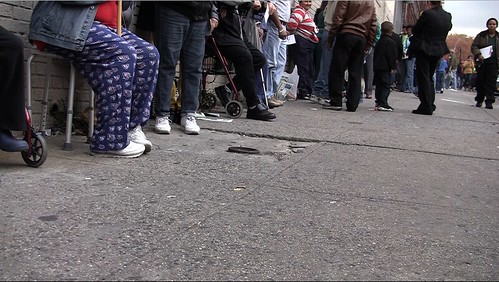The Cost of Hunger in New York City
Tina Williams, 35, mother of two boys aged 11 and 1, studies medical billing and coding at ASA College in New York City. For the second time this winter, Williams waited in line for hours to receive two quarts of free milk from the Milk From the Heart truck on the corner of Evelyn Place and Jerome Avenue in the Bronx.
“We can’t eat the way we would like to eat. We have to eat what’s available,” said Williams. “My food stamps ran out and now I have to wait two hours in the cold for food for my family.”
One in four children in New York City live in food insecure households, the technical term for hunger. The number of hungry families is now growing in New York City rivaling the South where food insecurity rates rank among the highest in the nation. Food pantries and soup kitchens are seeing a rise. In the past year alone, St. John’s Bread & Life, the largest emergency food provider in Brooklyn, has seen a 30 percent increase in demand for food among families with children, according to a study by the Children’s Defense Fund of New York. Three of the 19 counties in the United States with more than 100,000 food insecure children are in New York City (Kings, Queens and the Bronx), according to Feeding America’s latest hunger studies charts.
The major difference between hunger in New York City and the more familiar scenes of global hunger is that here the problem is not caused by a lack of food but, rather, by a lack of income to buy food. It is the ultimate illustration of urban poverty. Now the city’s hunger problem has become so severe that advocates are worried that the cost of hunger will provoke lasting damages to health care and educational systems. And without action the problem can only get worse with the next generation of New York children born into poverty.
“We tend to think of food insecurity in a third world sense,” explained Jonah Nelson, 24, Program Associate at the New York Institute for Children, Homelessness and Poverty, “but you’re not seeing people dying of malnutrition that way. You see people that on the outside you may not think are hungry, but they may not have food 5 to 7 days out of the month, or they are drastically reducing the quality of their food.”
Inconsistent access to nutritious food is one of the leading causes of obesity and other health related issues among children from low-income families. They often consume less expensive, high calorie, high fat foods that will eventually take a toll on their health. “You don’t find your fresh produce at the same price as something in a can,” explained Lorraine Gonzalez, 35, Director of Health Policy at the Children’s Defense Fund New York.
The relationship between food insecurity and obesity in this country is unique: the way food is consumed by food insecure households primes the body to pack on fat. “When they have food they end up eating as much as they can and then if their benefits or food stamps run out they will go hungry,” noted Nelson. “It’s a cycle of boom and bust that we’re seeing with a lot of kids and it’s creating some seriously adverse conditions that we’re going to have to pay for later on.”
Eventually, the cost of overfeeding and malnutrition combined is reflected in rising medical bills. $14 billion were spent in medical costs for obesity related issues in children, according to the Food Research and Action Center’s latest study.
“Poor nutrition is probably responsible for many of the illnesses you get as you reach your 50s, 60s and 70s,”explained Agnes Molnar, Co-Director of Community Food Advocates. “Our healthcare bills are ridiculous. We have to change a lot of things and I’m not sure we’re going about it the right way.”
Food insecure children have 30 percent higher rates of hospitalization than their food secure counterparts, according to a study conducted by Feeding America. With the average cost for a single hospitalization for pediatric illness at $11,300, the economic burden on low-income families is dire. In addition the uninsured seek out medical care only when they are really sick.
“There’s no real preventative medicine, people are more or less trying to survive,” Nelson pointed out.
Malnutrition has been proven to affect a child’s early cognitive development and increase his or her risk of future illness. “The kids need food to go to school. How can they focus if they are hungry?” exclaimed Williams. Other noted effects of food insecurity are grade repetition, tardiness, aggression, anxiety, absenteeism, and psychosocial dysfunctions especially among children 6 to 12 years of age, according to research conducted by
Feeding America.
With Christmas on her mind, Williams, now at the front of the line, two steps from receiving free milk for her young boys, simply exhaled. “Now we can’t even really afford the gifts for them,” she admitted. “We try our best, we stay together, and God bless we get to see another year and another Christmas.”



